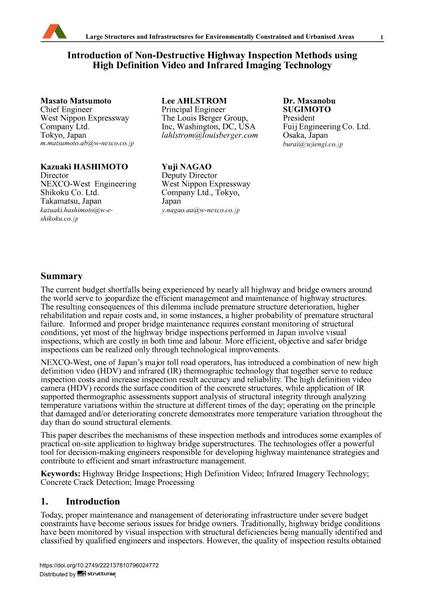Introduction of Non-Destructive Highway Inspection Methods using High Definition Video and Infrared Imaging Technology

|
|
|||||||||||
Bibliographic Details
| Author(s): |
Masato Matsumoto
Lee Ahlstrom Masanobu Sugimoto Kazuaki Hashimoto Yuji Nagao |
||||
|---|---|---|---|---|---|
| Medium: | conference paper | ||||
| Language(s): | English | ||||
| Conference: | IABSE Symposium: Large Structures and Infrastructures for Environmentally Constrained and Urbanised Areas, Venice, Italy, 22-24 September 2010 | ||||
| Published in: | IABSE Symposium Venice 2010 | ||||
|
|||||
| Page(s): | 322-323 | ||||
| Total no. of pages: | 8 | ||||
| Year: | 2010 | ||||
| DOI: | 10.2749/222137810796024772 | ||||
| Abstract: |
The current budget shortfalls being experienced by nearly all highway and bridge owners around the world serve to jeopardize the efficient management and maintenance of highway structures. The resulting consequences of this dilemma include premature structure deterioration, higher rehabilitation and repair costs and, in some instances, a higher probability of premature structural failure. Informed and proper bridge maintenance requires constant monitoring of structural conditions, yet most of the highway bridge inspections performed in Japan involve visual inspections, which are costly in both time and labour. More efficient, objective and safer bridge inspections can be realized only through technological improvements. NEXCO-West, one of Japan’s major toll road operators, has introduced a combination of new high definition video (HDV) and infrared (IR) thermographic technology that together serve to reduce inspection costs and increase inspection result accuracy and reliability. The high definition video camera (HDV) records the surface condition of the concrete structures, while application of IR supported thermographic assessments support analysis of structural integrity through analyzing temperature variations within the structure at different times of the day; operating on the principle that damaged and/or deteriorating concrete demonstrates more temperature variation throughout the day than do sound structural elements. This paper describes the mechanisms of these inspection methods and introduces some examples of practical on-site application to highway bridge superstructures. The technologies offer a powerful tool for decision-making engineers responsible for developing highway maintenance strategies and contribute to efficient and smart infrastructure management. |
||||
| Keywords: |
image processing Highway Bridge Inspections High Definition Video Infrared Imagery Technology Concrete Crack Detection
|
||||
